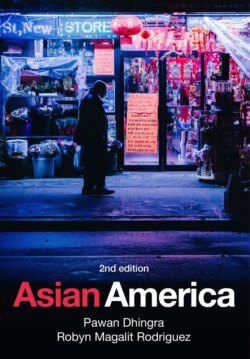Читать книгу Asian America - Pawan Dhingra - Страница 11
1 Introduction
ОглавлениеAsian Americans are overrepresented among college graduates, with 50% of Asian Americans age 25 and older having gained at least a bachelor’s degree, compared to a quarter of the US population as a whole.1 They are accomplished professionals in fields ranging from the sciences to the arts. They have a high rate of small-business ownership. They are seen as model workers. At the same time, a greater percentage of Asian Americans than non-Hispanic whites live in poverty, and Asian Americans are more likely than the US population overall to be uninsured.2 A range of Asian Americans rely on public welfare programs, work in low-wage and in ethnic enclaves (e.g. Chinatown, Koreatown, Little Saigon), encounter racial stereotypes as foreigners, suffer from untreated mental health illnesses, are undocumented, and/or are victims of hate crimes.3
Yet, even with all of these variations and contradictions, it is not the multifaceted lives of Asian Americans alone that make them necessary subjects of study. The experiences of Asian Americans speak to more than just this group. Their lives provide insight into a host of broader topics that have been the key focus of academic and popular concern. These topics include how race shapes people’s lives; how immigrants gradually assimilate – or do not – to their surroundings; how war and empire building impact families; how transnationalism influences people’s social and economic opportunities; how small groups come together or engage in conflict; how people self-identify; what leads to academic success and failure; and more. The goal of the book is to shed light on such general sociological questions through the experiences of Asian Americans.
Learning how Asian Americans experience these and other issues, moreover, tells us about the United States as a nation, for the nation is well understood based on how it treats its newcomers and minorities. According to the United States’ self-proclaimed creed as a nation of immigrants, all persons are welcome to make a new life here. But is there true equality in schools, the workplace, media, and elsewhere for all persons, regardless of country of origin, religion, gender, or other social categories? Can the nation become truly multicultural, or will the cultural definition of the United States remain Anglo-Saxon and Christian? What do the hate crimes against Asian Americans in response to the coronavirus reveal about the country? Do immigration laws give immigrants control over their lives upon entering the United States, or do they privilege the interests of others? Does growing economic globalization create more transnational lives? How have racism and colonialism been key parts of American history and contemporary life? In other words, the challenges and opportunities that Asian Americans face inform the true nature of the nation, and these are central issues that this book grapples with.
And of course, the study of Asian Americans matters to Asian Americans and those who are interested in our well-being. A text that centers on the lives of Asian Americans affirms their experiences while also informing the human social condition more broadly.
